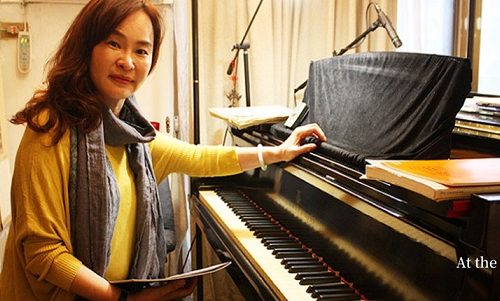人物專訪:雕塑家楊柏林-生活、自然與藝術Interview with Yang Buo-Lin, Sculptor
(English Article Follows)
文 / 張家嫻 攝影/ 楊柏林工作室 圖片/ 楊柏林工作室
採訪前看了許多楊柏林老師的作品、採訪,直到採訪的當天,見到楊柏林老師,以及「蕨知苑」,體會到藝術與自然共存,是如此的極致。
「蕨知苑」位於外雙溪的山麓,蜿蜒的山路岔路旁,隱約看到刻著棕色的小招牌,那就是進入「蕨知苑」前的告示。楊柏林,知名雕塑家、畫家、詩人,山石山象國際藝術負責人、同為亞細亞雕塑家協會理事長,參與公共藝術、景觀設計與建築規劃,以及各類藝術作品發表,殊榮無數。
正式採訪前,老師領我們先參觀了「蕨知苑」,這棟建築物已經不能用房子來形容,而是與大自然融為一體的棲身之地,從玄關開始就是一場藝術展,映入眼簾的是楊柏林老師的作品,陽光從一整片的玻璃落地窗折射進來,光線打在摩天大樓上,或許是因為溫暖的陽光,讓它舒服的扭轉脖子,形成了一件獨一無二的藝術品。
穿過玻璃落地窗,來到了庭院,粉紫色蘭花綻放,露出微笑迎接著我們到來,一旁的蕨類慵懶垂掛著,走過的層層空間都是驚奇,每一扇門、樓層都是一個舞台。最後來到了一扇木頭大門前,門閂開啟,進入到充滿禪意的場域,入門左側是一尊佛像靜靜佇立玻璃窗邊,楊老師領我們入座,開啟了我們的談話。
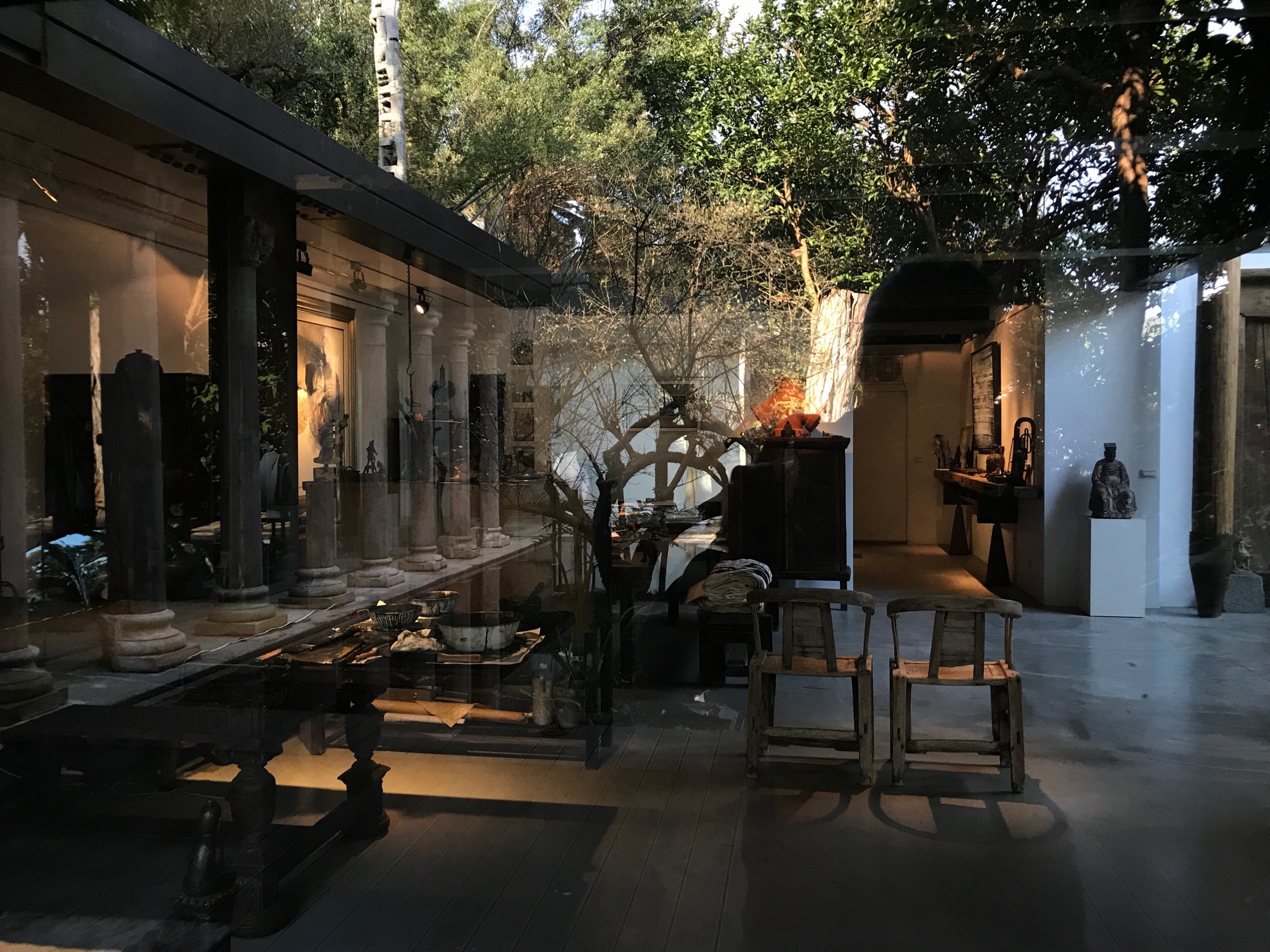
那時隱約感受到,將來要做的是藝術家,只是當下不知道,那叫做藝術家 。
從小我就喜歡畫畫,喜歡夢想,喜歡孤獨,在我的家鄉,那裏只有貧瘠的海,只能當漁夫養牡蠣。2017年知名作家蔡詩萍,專訪楊柏林老師聊到,國小三、四年級跟著母親去牡蠣田幫忙時,因沒有手套,被牡蠣殼給割傷手,在已是黃昏的時刻,看著流出的血,第一時間感受到的不是痛,而是血與黃昏融為一體,壯麗的感受,那種與大自然連結一體的畫面,讓我隱約感受到,將來要做的是藝術家,只是當那時的年紀,並下不知道,那叫做「藝術家」,能想到的就是,以後要當一個畫畫的人。
我是特殊、特別的存在,我建立我自己的傳奇,就因為我的經歷與別人不同。
我所有的東西,都是自己創造的,用自我獨特方式存在形成風格。當藝術家若沒有自己的風格,那不是藝術,是捏造的。我喜歡所有藝術,也喜歡生活美學,空間設計,我的每處空間,如同舞台,從材料尋找開始,到累積裝置,都是親手去做,因為那才能形成獨特的美學次序。我空間的畫,都是專為我空間而畫的,意境是不同的,如同酒一般,釀造出的風味都是獨一無二的。我會參觀別人藝術品,但「不參考」。我有專屬自己的DNA。因為我的生命經歷特別,別人寫不出來也模仿不來。我是藝術家裡和藝術家是不聊藝術的,因為每個人喜歡的不同,像酒一樣,每個人喜歡的口感,風味皆不同。
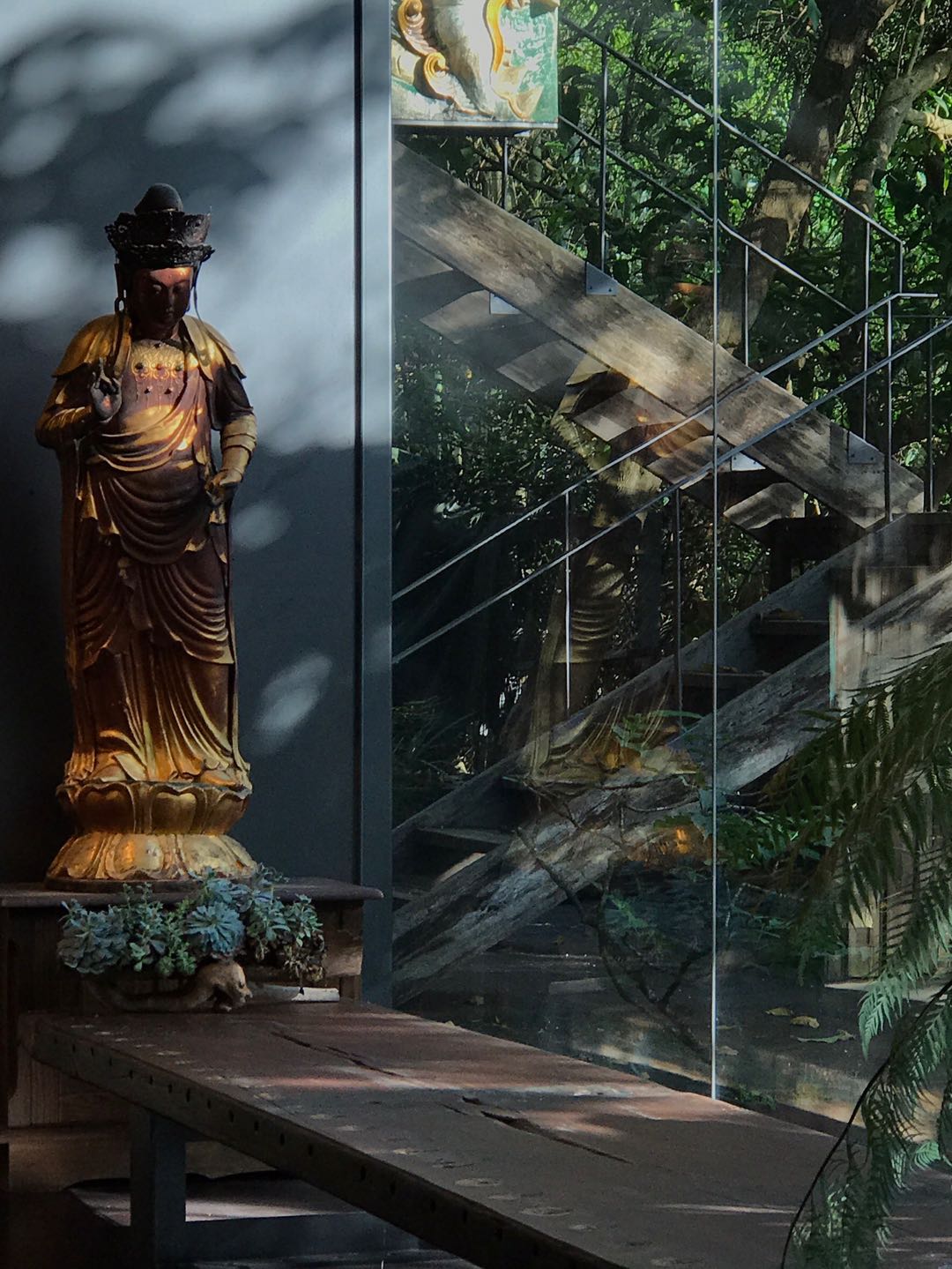
在藝術這條路上,遇到困難或瓶頸的時候,「不設限」是最好的解套方式 。
藝術對我而言,是開放式的,我從不侷限自己,也不設限自己只在一個領域。一般藝術家會只選擇自己所喜歡的藝術,甚至會排斥不喜歡的,但藝術之所以美好,就是因為藝術不受限任何形式。我的方式是在生活中每個平凡的小細節,用看的、用體會的做為藝術的創作來源。我喜歡抓住生活中,最重要核心人事物,並將其融入在創作中,藝術和生活是息息相關的,就連每天簡單用來掃地的掃把,只要用心的去體會,都是有含意的。
在2010年當代藝術館展出的Here I am 其中展出作品「你是誰」,就是以每天日常簡單掃地與掃把的關聯,引發創作靈感。同樣都是掃把,一個是竹子做的,另一個則是以紅、綠色塑製掃把,但兩者共同點為柄都是木頭,我將柄綁在一起,代表許多人事物是有共通連結的。我喜歡自我發掘,身歷其境的去看到那棵樹、這朵花的成長,這些無法從書上去體驗的,因為這是活生生的生命過程。所以在藝術這條路上,遇到困難或瓶頸的時候,「不設限」是最好的解套方式。
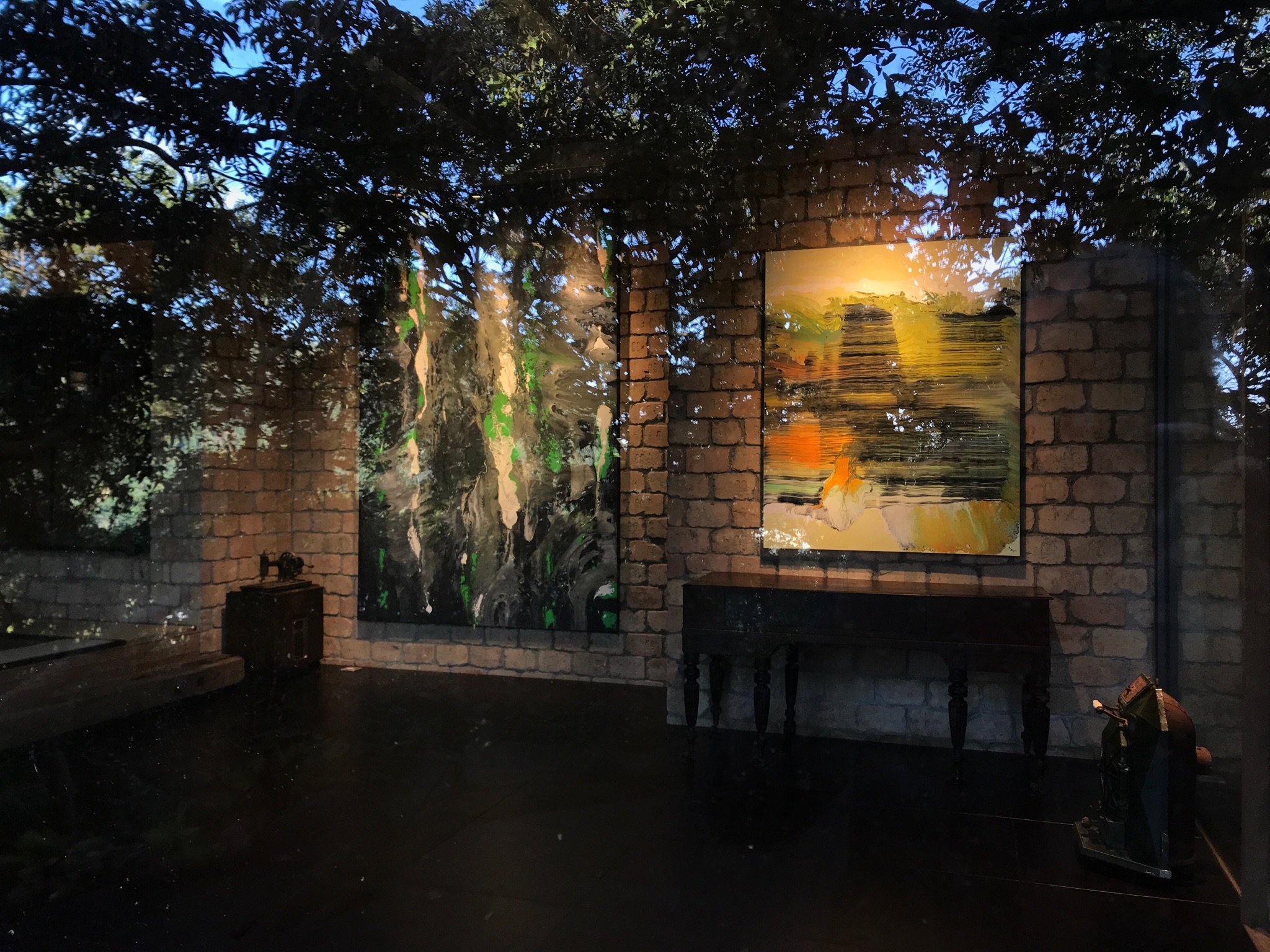
你會什麼,做那件事情就對了 !
你會什麼,做那件事情就對了! 重點是要自己喜歡的,若想從事藝術這條路,我給的不是建議,而是說明藝術這件事情,藝術是一種與生俱來的敏感度,當喜歡一件事情時,就會有所堅持。若抱著嘗試看看的心態,非強烈到著迷的程度,那這條路是行不通的。你要自己喜歡,才能說服別人喜歡,若自己都不喜歡,又怎會奢望別人喜歡你的創作呢?
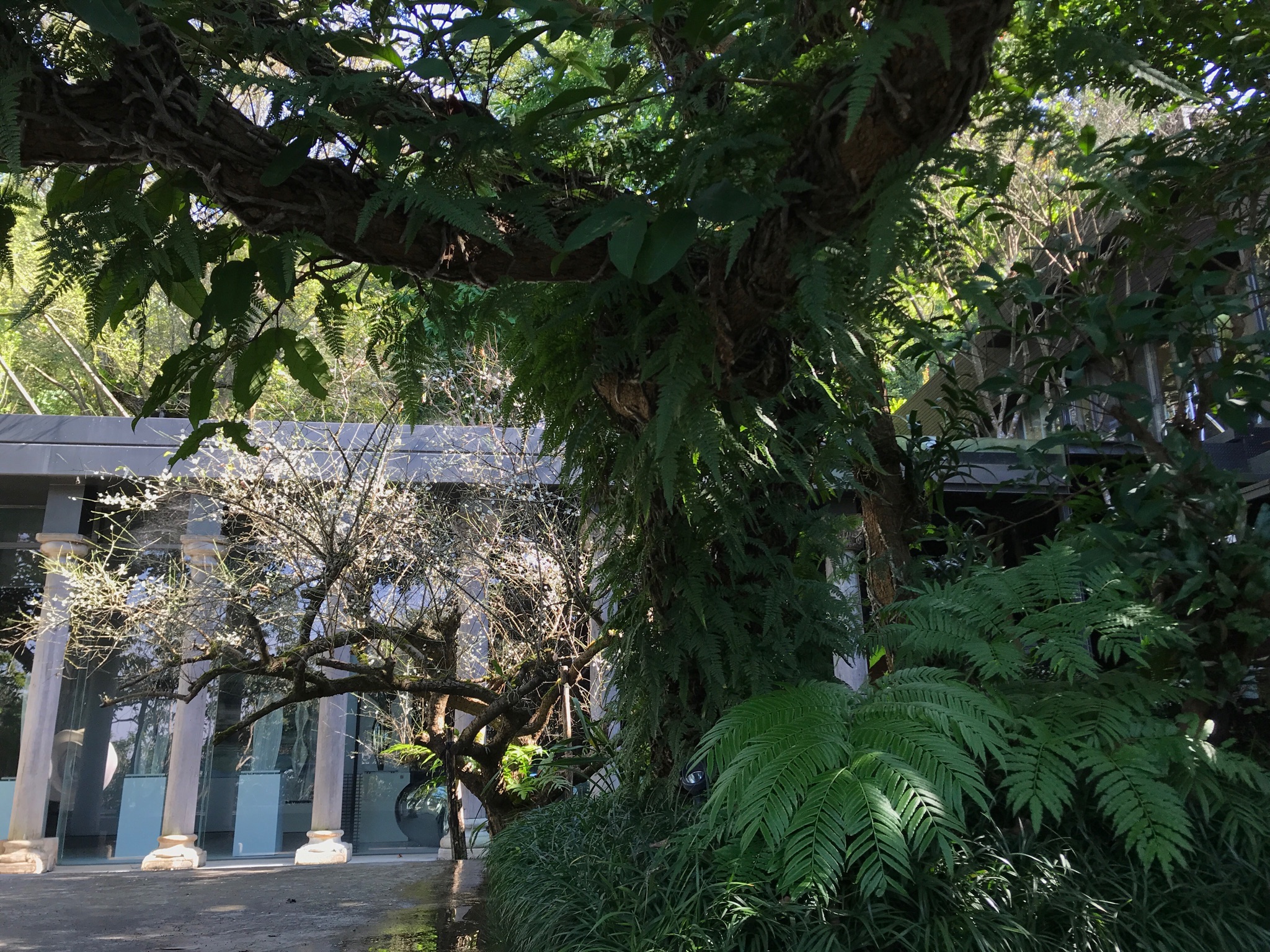
後記:
聊著聊著,飛來一隻嬌客,在老師面前揮動著小翅膀,老師眼神溫柔的和它對話,然後它像是聽懂了般,張大雙眼,乖乖地停在綠枝葉上,「它聞到了酒味,就飛進來了,因為這是他的地盤,它想一起加入我們」,楊老師笑笑地說。
如同楊老師在「坐看雲起」書中所述「周遭的植物、松鼠、落葉、昆蟲、甚至蛇都有了更親密的關係,連同他們都已經不是過境之客」。此刻夕陽西下,看著長髮披肩,原本面容冷酷的楊柏林老師,其實是把最柔軟的那一面獻給了大自然,因為大自然給予我們的,遠比我們想得更多。而「蕨知苑」就是給予天地萬物最好的回應。
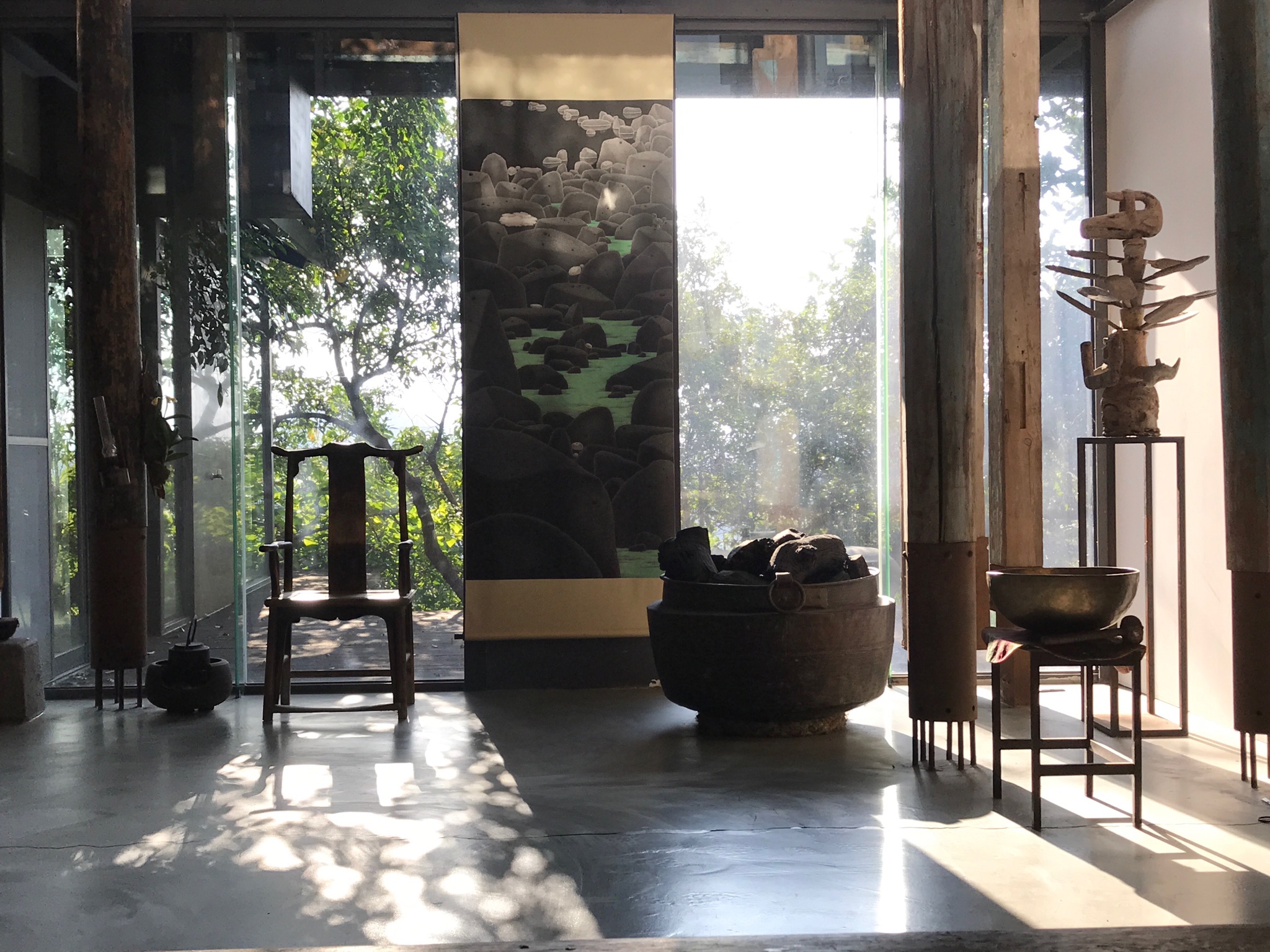
Life,Nature and Art
Prior to visiting Master Yang Buo-Lin’s studio, “Jue Zhi Yuan” (roughly “ Garden of Internal Awakening”), for this interview, I was able to view many of his artworks, and read interviews conducted by other professional writers. However, it was only on the day of the interview, that I began to understand that art and nature could coexist in such perfect harmony. “Jue Zhi Yuan” is located in the foothills of Wai Shuang Xi (in the same valley as the National Palace Museum). Along the side of a narrow winding road, there is a small, understated brown sign, which is the only notice that one has arrived at “Jue Zhi Yuan”. Master Yang Buo-Lin is a well-known sculptor, painter, and poet. He is the Head of International Art Company of Shang-Shr Shangshan, and the Chairman of the Association of Asian Sculptors. He has created many pieces public sculpture, and is active in landscape design and architectural planning, as well as the promotion and exhibition of various works of art.
Before our interview, Master Yang leads us on a tour of his home and studio. This building can no longer be accurately described as merely a “house”, but has evolved into a residence which is in complete harmony with Nature. At the entrance of “Jue Zhi Yuan” is an art exhibit – it beckons the visitor to see and enjoy more of his wonderful artworks. The sunlight is directed into the generous exhibition space via large panes of floor-to-ceiling glass, picture windows. The sunlight strikes the metal skyscraper sculpture – the warm sunlight gives the layered sculpture a feeling of gentle movement, forming a unique piece of art.
From the initial exhibition space, I enter an interior courtyard, which is open to the sky. An elegant, pink-purple orchid seems to welcome us. The lazy ferns recline in the afternoon sunlight over the side retaining walls. Each space that I walk through is unique and amazing. Every door on each floor is an entrance to another stage. Finally, we approach a grand wooden door, which opens into a very spiritual, meditative space. On the left side of the entry is a statue of Buddha standing quietly next to a large glass window. Master Yang directs me to take a seat and then we begin our conversation.
“When I was a young boy, I had the vague feeling that my life was to be involved with art”
Master Yang begins his remarks, “When I was a young boy, I had the vague feeling that my life was to be involved with art. However, at the time I was so young, I really didn’t have any idea what exactly an “artist” was! From that time, I always enjoyed painting, daydreaming, and my individuality – I didn’t have many friends since I lived near the ocean. Where I grew up, there weren’t many people, only the open sea and a few fishermen who also cultivated oysters.”
In an interview conducted in 2017, with a well-known writer, Tsai Shr-Pin, Master Yang related, “When I was in elementary school, I went with my mother to the seaside to pick oysters – my mother’s livelihood. However, it was a tough life as we were too poor to afford protective gloves, which caused our hands to bleed from the sharp oyster shells.“ However, Master Yang recalled, “The first time, at the end of a day’s collecting oysters, as my hands were bleeding into the saltwater, I was surprised that I did not feel pain. Rather the mix of my red blood and the yellow-orange sunlight at sunset was quite artistic and strangely aesthetic – an integration of people with Nature. This reinforced my feeling that my future was to be in art, and I thought that I would become a painter, as that was my limited understanding of art at the time. This is an indelible memory of my youth.”
“I am somewhat of a different type of artist. I’ve built my own artistic style, from my own set of unique experiences”
All my creations are from my own mind and hands – I feel that if an artist does not have his own style, it is not really art, but just a fabrication. I like all forms of art, life’s aesthetics and the creation process – including space design, searching for suitable aesthetic materials, assembling, and completing the work of art. All of the paintings in my studio are designed specifically for each interior space. Every artist’s conception is different, and artistic styles are unique. I enjoy other artists’ works, but will not integrate them into my psyche or creative thinking; I have my own “artistic” DNA. Because my life experience is so different, it can’t be imitated. I don’t discuss art with other artists, because while other artists may like to share their experience, like fine wine, I prefer to be unique and special.”
“In the development of art, when difficulties or bottlenecks are encountered, the best solution is to have a “no limits” problem solving” methodology
“Art is an “open forum” for me. I do not limit myself, nor do I restrict myself to one form of art. Most artists will only be involved with the form of art that he likes best or has the greatest skill level – and may even reject other forms of art. However, I feel that art is beautiful because it is not limited to any specific form. I try to draw upon every little detail of my life – to use my experiences as a source of artistic creation. Art and life are closely related. There is even artistic merit in the broom that is used to sweep the floor daily, as long as one’s heart is into the experience. For example, in 2010 at the Taipei Museum of Contemporary Art, I held an exhibition titled, “Who are You?”. One of the pieces of art was inspired by the simple daily task of sweeping the floor with a broom. I created a “two-headed” broom connected in the middle by a wooden handle. One broom head is made of bamboo, the other broom head is made of red and green plastic. The brooms are integrated by the wooden handle, which represents that all people have a common connection. I like to evolve artistically from experiences in my life, for example, carefully noting the growth of trees and flowers. This can’t be experienced from a book, but must be experienced first-hand, because this is a living, evolving process.”
“What You Know, it is Right Thing to Pursue”
“The key idea is to “pursue what you like”. If you wish to become an artist, I really cannot give you any concrete advice. I can only explain to you what I feel Art is. While much of Art is borne from an innate sensitivity, there is a lot of effort and personal sacrifice involved. Art requires perseverance – if you are really dedicated, you will stick to it. If you are only “trying Art out” just to see if you can be “successful”, then Art will not work for you. You have to enjoy the “process” of Art at all stages – from its conception to the final artwork – in order to convince others to like it, as well. If you don’t like your Art, how can you expect others to like your creation?”
Postscript:
Following our conversation, a small dragonfly is flying around Master Yang. Master Yang begins to chat quietly with the dragonfly. Then the dragonfly calms down and politely lands on a leaf of a plant in front of Master Yang – it seems to understand, Master Yang remarks with a smile, “The dragonfly said that when he smelled the open wine, he flew in to join us, because this is part of his home and he feels welcome, safe and comfortable.” As Master Yang stated in his book Sitting in the Clouds, “The plants, squirrels, leaves, insects, and even the snakes have an intimate relationship with my home; they are no longer guests.” At that moment, as the sun set, I see the gentleness of Master Yang’s face with his long ponytail in the waning light. The “Jue Zhi Yuan” truly reflects Master Yang’s artistic nature and outlook on the world.



